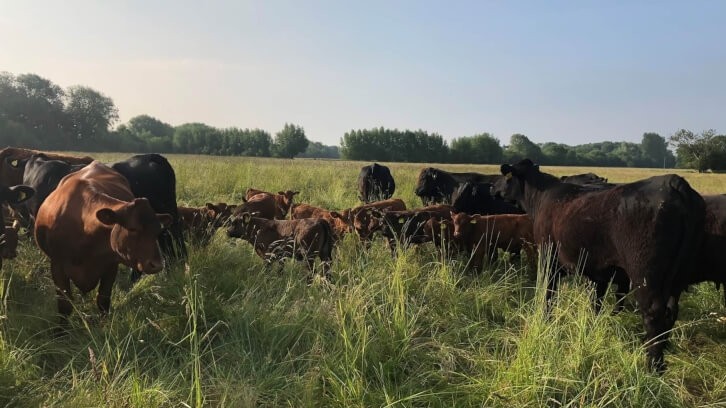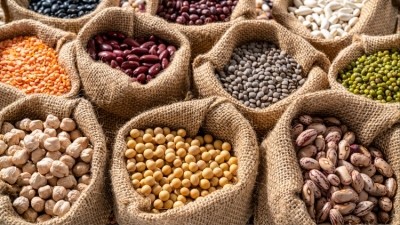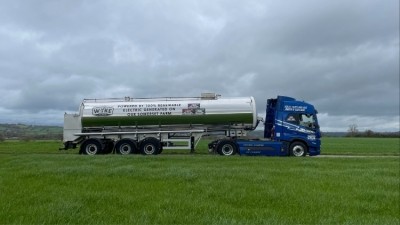Short read
Regenerative grazing for carbon sequestration

Situated just outside Oxford in the UK, FAI Farms has adopted techniques which aim to preserve and build soil carbon stocks – and wants the data to show the difference.
FAI Farms keeps both suckler cows and dairy beef calves, which it finishes on a mixture of grazed grass and forage.
Regenerative farming techniques like rotational grazing seek to build soil organic matter – and therefore carbon content – so that’s the direction in which the farm is heading.
“In the past we were set stocking and saw better grass growth when we had a project focused on moving to rotational grazing,” said FAI Farms director, Karl Williams.
“We wanted to better understand our baseline data and see where we moved to and how that was done,” he continued. “Soils offer a big opportunity for removing carbon from the atmosphere, and this has benefits to the soil itself, too.
“Agriculture is currently the only industry that has the opportunity to reach net zero. Both the brands that we work with and the NFU has a target to get there by 2040, which means that we need to have achieved a 50% reduction by 2030 to be on track.”
Measuring soil carbon storage
Baseline measurements were essential in calculating how much carbon was already stored in the farm’s soil. So in 2021, Williams worked with Agricarbon to select three of the farm’s 70 fields to represent the farm. Samples were taken and geo-located across each field, which will allow them to be repeated in 2026.
“We looked at different carbon calculators but found that they could be very focused on emissions rather than sequestration. When we spoke to Agricarbon, they were very knowledgeable and the sampling procedure was very straightforward. They had a core expertise in the subject.”
Standard carbon analysis of soils is usually done to 30cm depth, but as there can be a lot of churn at this level due to farming practices, FAI Farms went deeper – up to 1m.
“In terms of the baseline data, we were only just into year two of our transition to regenerative farming when Agricarbon did the initial testing on farm,” Williams said. “Not having had a previous baseline meant we didn’t really know what to expect in relation to the results; that’s why we felt it was so important to get an accurate baseline done.”
Regenerative farming practices
FAI Farms is a 486-ha holding which, alongside commercial farming, offers training, strategic advice, and data services to the agricultural industry. Its focus is on sustainability, and following its three Es framework:
- Economically viable
- Environmentally sound
- Ethically acceptable
It mostly comprises permanent pasture, as well as parkland, herbal leys, and lucerne. It has been part of Countryside Stewardship and the team is now looking at which sustainable farming incentive options can complement existing and planned management.
The core enterprise is a herd of 95 organic Salers x Aberdeen Angus suckler cows, with replacement heifers retained for breeding and steers and surplus heifers taken through to finish.
The cows calve outside in May and June, and calves are gradually weaned at 10 months old through a low-stress system. As the herd is Pasture for Life certified no concentrate is fed, and animals are finished at 22-24 months old and 625kg liveweight.
“Our aim is to keep cows out all year. For winter grazing we split the parkland into half-hectare cells, which gives us enough grazing for a 150-day winter as each cell is grazed for 24 hours.”
This system of grazing is one of the management practices that has been adapted and adjusted to suit the commercial farming operation and tie in with the farm’s regenerative approach.
“The basic principle of our pasture management is to graze a third, trample a third, and leave a third. However, we aim to never take more than 50% of the grass as that starts to impact the plant. It’s an adaptive approach based on the outcomes we are looking for.”
Biodiversity benefits
As well as growing more grass, the farm is also seeing more biodiversity, and now wants to measure those improvements, too.
“Some of our permanent pasture fields have between 40 and 60 plant species present in the ley. It’s very interesting what the cows choose to eat; some will go straight to thistles or nettles, and cocksfoot seedheads are a favourite.
“The food supply chain is complex; it wants a consistent supply of a consistent product, but farming thrives on diversity. There are so many opportunities in this space; ultimately farming is about food production, but we’re also tasked with so much more than that.”
Modelling and achieving net zero
So what’s next? From a soil carbon perspective, Agricarbon will carry out second samples on the original sites in 2026, which will allow measurement of what has or hasn’t changed in soil carbon stocks over the five-year period.
“I would hope to see an increase in our soil organic carbon percentage levels, especially with some scientific views suggesting that permanent pastures can reach an equilibrium of soil organic carbon after 20 years. I would hope the figures disprove this concept.”
Alongside the physical measurements, the farm has been inputting data into Trinity Ag Tech’s ‘Sandy’ calculator.
“The initial results are showing that we could already be net zero."
Meanwhile, the farm team have been collecting information for 65 different carbon metrics, with the aim of understanding which are key.
“Measuring carbon stocks and sequestration on farm can quickly become very complicated, and many metrics are expensive and time-consuming to measure.
“We hope to find out if there are certain iceberg indicators that farmers can use. Care needs to be taken that we don’t make management decisions based on a handful of results. This is a fast-moving area, and we have more questions than answers.”
Williams also sees opportunities for tenant farmers to use these measurements to show how their farming practices have benefited soil health, or as a tool for landlords to ensure that land is cared for in a holistic manner during the rental period. Taking baseline chemical soil samples at the start of a tenancy is routine, with tenants expected to hand land back at the same indices.
“We should be looking at more than just nutrient status in tenancy agreements. We need to recognise the potential cost impact or cost benefit in regard to our management practices and improving soil health, whether that be soil organic carbon or infiltration rates.”

















